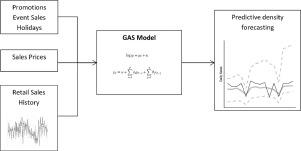Journal of Retailing ( IF 8.0 ) Pub Date : 2021-06-20 , DOI: 10.1016/j.jretai.2021.05.003 Henrique Hoeltgebaum , Denis Borenstein , Cristiano Fernandes , Álvaro Veiga

|
Forecasting is one of the fundamental inputs to support planning decisions in retail chains. Frequently, forecasting systems in retail are based on Gaussian models, which may be highly unrealistic when considering daily retail data. In addition, the majority of these systems rely on point forecasts, limiting their practical use in retailing decisions, which often requires the full predictive density for decision making. The main contribution of this paper is the modeling of daily distribution centers (DCs) level aggregate demand forecasting using a recently proposed framework for non-Gaussian time series called score-driven models or Generalized Autoregressive Score (GAS) models. An experimental study was carried out using real data from a large retail chain in Brazil. A log-normal GAS model is compared to usual benchmarks, namely neural networks, linear regression, and exponential smoothing. The results show the GAS model is a competitive alternative to retail demand forecasting in daily frequency, with the advantage of producing a closed form predictive density by construction.
中文翻译:

零售配送中心短期需求预测的分数驱动模型
预测是支持零售链规划决策的基本输入之一。通常,零售业的预测系统基于高斯模型,这在考虑日常零售数据时可能非常不切实际。此外,这些系统中的大多数依赖于点预测,限制了它们在零售决策中的实际使用,这通常需要完整的决策密度预测。本文的主要贡献是使用最近提出的非高斯时间序列框架对每日配送中心 (DC) 级别的总需求预测进行建模,称为分数驱动模型或广义自回归分数 (GAS) 模型。使用来自巴西一家大型零售连锁店的真实数据进行了一项实验研究。对数正态 GAS 模型与通常的基准进行比较,即神经网络,线性回归和指数平滑。结果表明,GAS 模型是每日频率零售需求预测的一种有竞争力的替代方案,其优势在于通过构造生成封闭形式的预测密度。











































 京公网安备 11010802027423号
京公网安备 11010802027423号